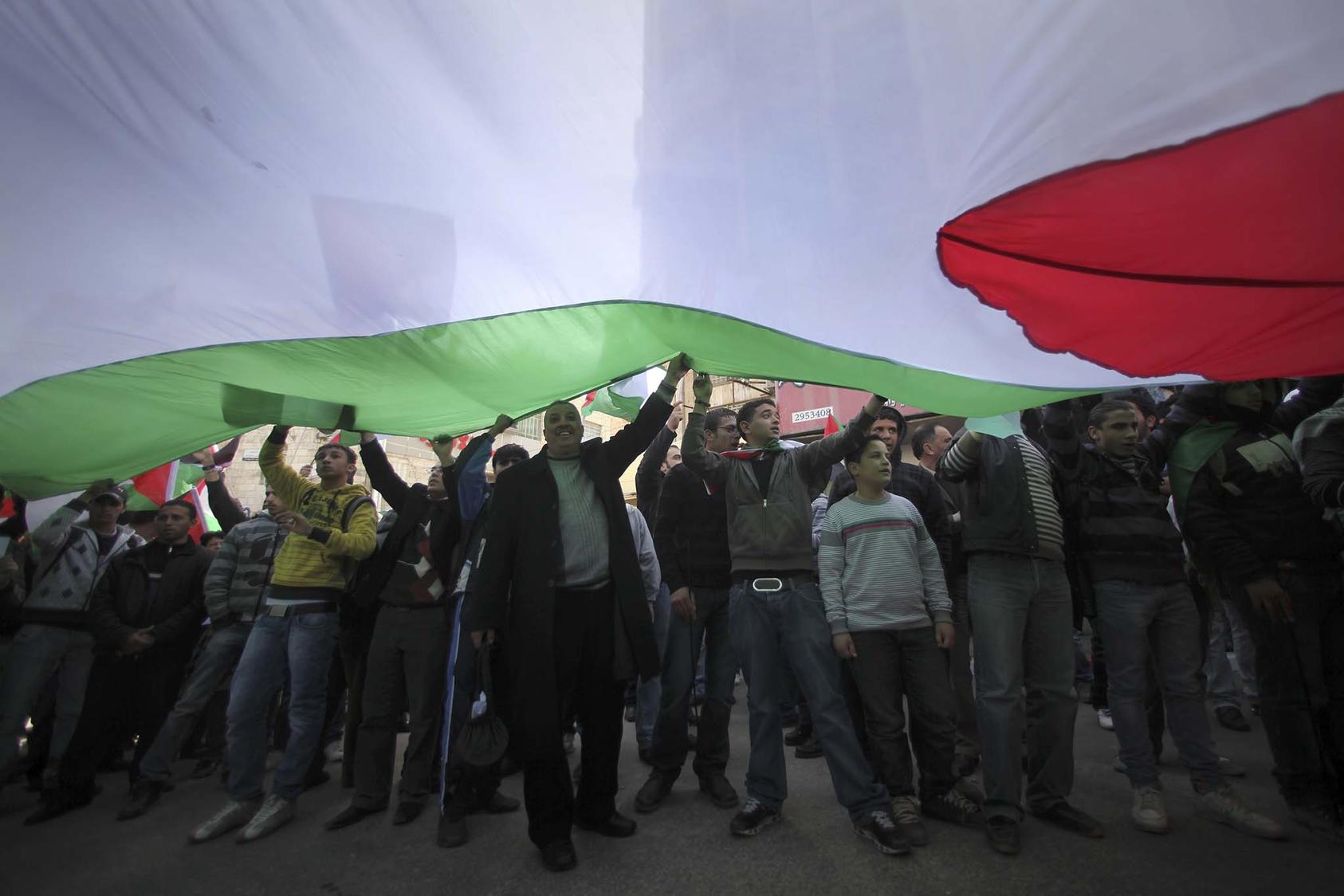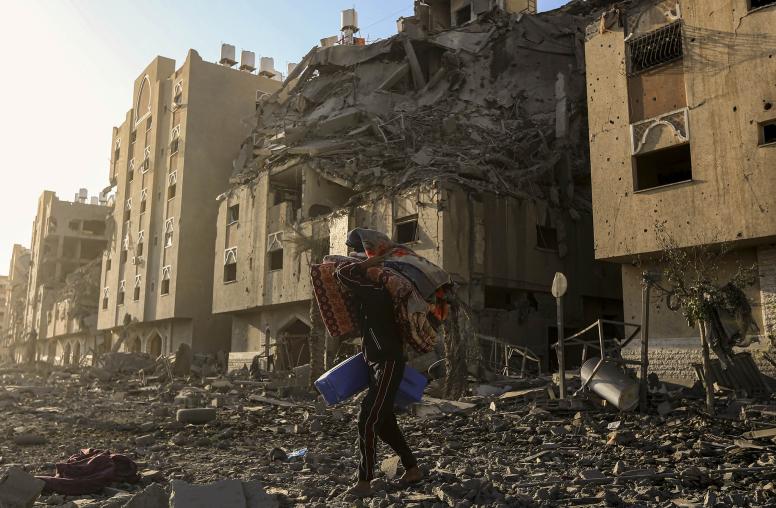Palestinians’ Divided House Hampers Peace
A decade after their own Arab uprising and in the wake of the most recent violence, Palestinian politics are as fractured as ever.
In a scene reminiscent of the uprisings that swept the Middle East 10 years ago, Palestinian protesters took to the streets over the weekend, chanting, “The people want to bring down the regime.” The recent death of activist and Palestinian Authority critic Nizar Banat while in the custody of Palestinian security forces was the proximate cause for the unrest. But Palestinians’ disenchantment with their leadership has much deeper roots. Fifteen years after the last national elections, the Palestinian polity is as fractured as ever, adding but another obstacle to resolving the seemingly intractable Israeli-Palestinian conflict.

Overshadowed by the recent round of Israeli-Palestinian fighting, Palestinian Authority (PA) President Mahmoud Abbas called off long overdue Palestinian legislative elections only weeks before the violence. The last Palestinian general election, held in 2006, had a profound impact, resulting in the ongoing West Bank-Gaza divide. The now-postponed 2021 elections could have been a critical first step in addressing this division and the broken Palestinian political architecture.
Intra-Palestinian political squabbles are not just a matter of dysfunctional domestic politics. Ongoing Palestinian division feeds the old trope that there is no Palestinian “partner for peace” and can be exploited by spoilers on all sides. The recent outbreak of violence only further highlights the need for active measures to address the conflict’s many flashpoints, including Palestinians’ sclerotic politics.
The Hamas-Fatah Divide
The Palestinians’ current crisis can, in part, be traced back to the Territories’ first real contested elections, in 2006.
After the death of the PA’s first president, Yasser Arafat, in 2004, his longtime aide Mahmoud Abbas won the presidency in 2005. Only months later, however, parliamentary elections saw Hamas defeat Fatah, the party of Arafat and Abbas — with Hamas taking 74 of 132 seats in the Palestinian Legislative Council (PLC), to Fatah’s 45.
Longstanding tensions between the two major Palestinian parties were heightened after Hamas’ victory. Hamas’ control of government — and its refusal to commit to nonviolence, recognize Israel or accept previous agreements made with Israel — resulted in the international community suspending aid to the PA. After months of internecine fighting, Hamas took over Gaza in June 2007. Abbas, in turn, formed an emergency government, based in the West Bank, which was recognized by the international community and saw aid restored.
The Palestinians and the Arab Uprisings
Four years later, amid the early euphoria of the Arab uprisings, tens of thousands of Palestinians took to the streets to call for an end to the Hamas-Fatah divide and to protest corruption and poor economic conditions during demonstrations that took place over 2011-12.
Even with Palestinians calling for an end to the division and neighbors like Egypt and Qatar attempting to broker lasting reconciliation, the Hamas-Fatah/Gaza-West Bank divide lives on, at the expense of the Palestinian people and hopes for a negotiated solution to the Israeli-Palestinian conflict.
This reality plays out clearly in public opinion polling 10 years later. In June 2021, a majority of Palestinians viewed the PA as a burden, and 84 percent believed there is corruption in PA institutions. Only 41 percent of those polled expressed optimism about reconciliation, and the majority did not think the PA government would be able to secure reconciliation or improve economic conditions.
Elections and Politics in 2021
In January of this year, Abbas announced PLC elections would occur on May 22 and PA presidential elections on July 31. Palestinians welcomed the announcement and registered to vote in record numbers.
However, Abbas and his closest advisers came to second-guess the decision. Unity within the Fatah Party has crumbled, with former officials splitting away and challenging the 85-year-old Abbas’ leadership. Spring polls suggested a close race between Hamas and Fatah, and a potential loss of the presidency for Abbas. On April 29, Abbas — whose term expired in 2009 — announced that elections would be postponed until Israel allowed the PA to place ballot boxes in East Jerusalem. Polling shows, however, that two-thirds of the Palestinian public believe Abbas really postponed the vote because “he was afraid of the outcome.” Hamas called the move “a coup.”
Today, the fault lines in Palestinian politics are near the deepest and most tenuous they have ever been. In Ramallah, camps have emerged between the Muqata’a (Abbas and his advisers), Fatah (the largest, most mainstream Palestinian political party) and Palestinian Liberation Organization (PLO) factions. Outside of the PLO factions stands Hamas, which has demonstrated an ability to unify despite internal competition in a way that Fatah and the PLO seem unable.
Fatah’s deterioration has, in part, been driven by the re-emergence into politics of three men: Nasser Al-Qudwa, Marwan Barghouti, and Mohammad Dahlan. In March, Al-Qudwa — Arafat’s nephew and a former foreign minister and U.N. ambassador — announced that he would form his own party to run against Fatah, in an effort to reform the party and PA. Al-Qudwa is a known figure among Palestinians, viewed as well-connected in Western capitals, but with minimal ground game or credibility in the Territories.
The bigger splash, however, has been the entrance into the ring of Marwan Barghouti, a one-time supporter of the peace process in the early years after Oslo who has been in Israeli prison since 2002, convicted of several counts of murder during the second Intifada. He previously declined to play an active political role but partnered with Al-Qudwa’s Freedom Party in the lead-up to the elections. While untested (and untainted) politically, Barghouti is almost certainly the most popular political figure among Palestinians, given his stature as a symbol of the Palestinian cause and unwavering resistance to Israeli occupation. Polls suggest he would have handily won a presidential election. However, his currency with Israel and the international community is limited.
Finally, Mohammad Dahlan has emerged as a more active political player than ever before. A former security chief and exiled rival of Abbas, Dahlan has been vocal in his criticism of the PA president, saying in an interview for Saudi television that Abbas had failed to meet his promises to reform Fatah and the PA and achieve peace with Israel.
In Gaza, Hamas is ascendant in public opinion, and potentially more recognized as a political actor in the region. In the past 18 months, Hamas leader Ismail Haniyeh attended Qassem Soleimani’s funeral in Tehran and met with leaders from Russia, Turkey, Morocco and Lebanon. After the recent round of violence, Hamas’ popularity has only grown among Palestinians frustrated by Israel’s actions and Abbas’ seeming inaction.
The Domestic Roots of International Stasis
Since the last round of Israeli-Palestinian negotiations in 2013-14, faith in the prospect of achieving a Palestinian state has eroded. According to a last round of polling, only 39 percent of Palestinians support a two-state outcome to the conflict, while 61 percent consider this outcome an impossibility. In the same poll, 49 percent of respondents said that armed struggle is the best means of ending the occupation, while only 27 percent preferred negotiations.
The Palestinian divide is frequently cited as an obstacle for peacemaking. Israeli skeptics of the peace process — before and after the Palestinian civil war — have long decried the lack of a “partner for peace.” The United States, European Union and regional states remain similarly frustrated by these realities, and given laws and dilemmas over how to deal with terrorist groups (such as Hamas), have yet to thread the needle.
The Biden administration had not been active on the Israeli-Palestinian issue until the fighting in May, in no small part because of the disorder in both parties’ politics and the seeming lack of opportunity for forward progress. But the most recent outbreak of violence thrust the conflict back to the forefront of international attention. Now is the time to understand how the United States can address the drivers of violence and the conflict at large.
Fresh Palestinian elections are clearly not a panacea for all the obstacles to peace. But a unified Palestinian polity is a critical step to resuming meaningful negotiations — without a single entity to negotiate on behalf of all Palestinians, any negotiated agreement will be rendered incomplete, if not impossible. The Biden administration has repeatedly said that Israelis and Palestinians “deserve equal measures of security, freedom, opportunity and dignity.” Part of achieving that for Palestinians means the opportunity to choose their leaders.
Although controversial, the United States should support Palestinian reconciliation and can do so through third-party meditation with allies like Egypt. The United States and virtually all of the international community considers Hamas’ indiscriminate rocket fire to be an act of terrorism. However, Hamas is also an undeniable part of the Palestinian political fabric. Many Palestinians view its actions as justified resistance — the most recent polling suggests that Hamas would win a considerable majority in a legislative election (41 percent of voters supporting Hamas vs. 30 percent for Fatah) and outperform Abbas in a presidential election. As Washington looks ahead, a nuanced and realistic policy seems necessary. As a recent report from the Center for New American Security suggests: “The United States must encourage intra-Palestinian reconciliation by becoming more flexible about the composition of the government that the Palestinians form.” While a fraught consideration, the U.S. decision to engage the Taliban in negotiations over the future of Afghanistan represents a precedent.
The United States can also exercise its leverage with Israel to ease restrictions that complicate holding elections, like allowing polling places in East Jerusalem, as agreed to under Oslo. Shifting American attitudes toward the conflict, and the new Israeli government’s desire to improve relations with the Biden administration and U.S. Democrats, could offer a new opportunity for the United States to encourage its ally to help foster Palestinian reconciliation and fresh elections. Additionally, the United States and the international community should use their leverage with the Palestinian Authority to push the leadership toward embracing this democratic necessity and provide technical assistance to help ensure a smooth election and to repair broken Palestinian political institutions.
A final element in revitalizing Palestinian institutions may draw from the region’s evolving relations. In the past year, the UAE, Bahrain, Sudan and Morocco all agreed to establish ties with Israel, while maintaining long-held positions toward the end of the conflict and expressing continued solidarity with the Palestinian cause. The United States, along with international partners, can and should work to bring regional actors into more proactive and constructive roles — pressuring both parties to preserve the possibility of a two-state outcome and cease provocative actions.
Ultimately, leading Palestinian political factions will have to decide to come together on their own. Palestinians’ reaction to the latest round of violence should be a cautionary moment for Palestinian leaders. In a rare show of political unity, hundreds of thousands of Palestinians in Israel, the West Bank and Gaza participated in a general strike to protest Israel’s actions in East Jerusalem and Gaza. If Palestinian leadership is unable to overcome their differences for the betterment of their people, they may be the next target of mass popular resistance.



